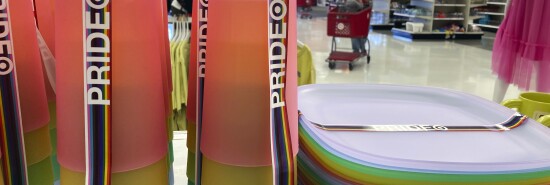
Target learns the Bud Light lesson: Go woke, go broke
Dominic Green
Video Embed
Raise a glass of Bud Light to Target, whose market value shed $10 billion in 10 days after customers revolted against Target’s range of Pride-themed tat. Celebrate by squeezing into a Calvin Klein mankini, as promoted by an obese “trans man” with saggy moobs, and then camping out in North Face, as advertised by Pattie Gonia, the “real-life homosexual” who dresses as Barbarella-era Jane Fonda, only with more chest hair.
In Remembrance of Things Past, real-life homosexual Marcel Proust describes the male genitalia as spoiling an otherwise perfect form. Had Proust bothered to get out of bed, he would have appreciated the “tuck-friendly” women’s swimsuits that Target sells to perfectly normal men with a perfectly normal desire to wear women’s clothes. But the American public can remember things past the day before yesterday. They aren’t buying it.
EVERY HOUSE MEMBER WHO VOTED AGAINST PASSING THE DEBT CEILING BILL
Shares in Anheuser-Busch, the owners of Bud Light, rose solidly from November 2022 until May, when Bud Light adopted Dylan Mulvaney, a transvestite specializing in aggressive parodies of little girls, as the 5 o’clock shadowed face of the world’s worst beer. Anheuser-Busch shares lost 17.5% of their value in May, erasing their gains since November. North Face’s share price, which has declined sharply since 2021, fell a further 22.7% in May and is now worth only a fifth of its 2020 high. Shares in Adidas, which had also risen for six straight months, fell by 5.5% in May after Adidas launched its summer swimwear with a Borat-style hairy man in a woman’s onesie.
Go woke, go broke. Target shares declined by 15% when it launched its Pride range and are now at their lowest since August 2020. Shoppers have thrown merchandise on the floor, confronted staff, and shown a “transphobic” reluctance to buy Pride-themed baby suits and toddler leggings, Pride-themed swimwear, and books with titles such as Bye Bye, Binary. The author of Bye Bye, Binary, an ex-Disney editor named Eric Geron, said he wrote it for “ages 0 to 4.” Geron is now probing what he calls “the young adult space” with a novel, A Tale of Two Princes: God Save the Queers. His illustrator, Charlene Chua, illustrated the pantsuited entitlement of Sen. Elizabeth Warren’s (D-MA) Pinkie Promises.
This is America. If you want a monarchy that suppresses free speech, move to Canada. This also being America, market forces stand in for moral frameworks, so choose where you spend your money. Panicking, Target has deployed the “Three D’s” of damage control: deny it pushed trans ideology on children, deflect attention by hiding the evidence, and deter questions by claiming it is being victimized by a “backlash” from Christians, conservatives, Republicans, and Southerners. “We had swimsuits in the front,” an anonymous Target employee in Arkansas told Reuters. After receiving orders from headquarters, the store tucked the offending items “in a random area in the back.”
The gender cult has to rub it in our children’s faces. They are Puritan perverts, formed in the image of the Christianity they no longer comprehend; there is a stripe in the Pride flag called “Spirit.” Substituting sexuality for the soul, they are morally compelled to interfere with children’s understanding of their bodies, just as an old-time preacher desired to catechize their minds. But why are their corporate partners playing along?
It’s just business. The birth rate is declining, the middle class is contracting, and the cost of living is rising. Target is an aspirational big-box store. It spots new trends and sells knockoff copies. Those trends are now generated online. Consider Target’s plus-sized mannequins. The chemical parody that is processed food has raised the obesity rate by 26% in the last 15 years. Young Americans, adopting the cant of feminism and racial identitarianism, rationalized their bloated online image as “body positivity.” So Target loosened the waistbands on its pants, bought “plus-sized” mannequins, and plastered the walls with pictures of Lizzo-scale slobs engaging in acts of affirmative exercise. It sold Americans’ sickness back to them.
CLICK HERE TO READ MORE FROM THE WASHINGTON EXAMINER
This was twisted, but it reflected reality. Almost everyone in America is overweight, and half the population is obese. But only about 2% are gay. Even fewer believe their soul has been born in the wrong body. Hardly anyone undergoes the trans baptism of surgical mutilation and hormone treatment. Look online, though, and half the teenagers in America are binding their chests and polishing their butt plugs. No wonder corporations, which are advised by chronically online strategists and stylists, keep getting it wrong. No wonder the Pride and authenticity pitch reeks of exploitation and fakery, which is to say, porn.
This culture clash isn’t just between the Left and Right. It’s between the shiny surfaces and fearful hollows of the digital world and dystopian shambles and struggling families of real life. This goes to the heart of the definition of a human being, and that explains why childhood has become a battleground. Childhood as we know it is a modern invention, a Romantic dream of blank-slate innocence. But innocence is a luxury product. The teenager, a child with an adult’s purchasing power, was invented to squeeze extra market shares from America’s midcentury boom in consumption. The child is being commercialized as America’s markets tighten. Why should we take pride in that?
